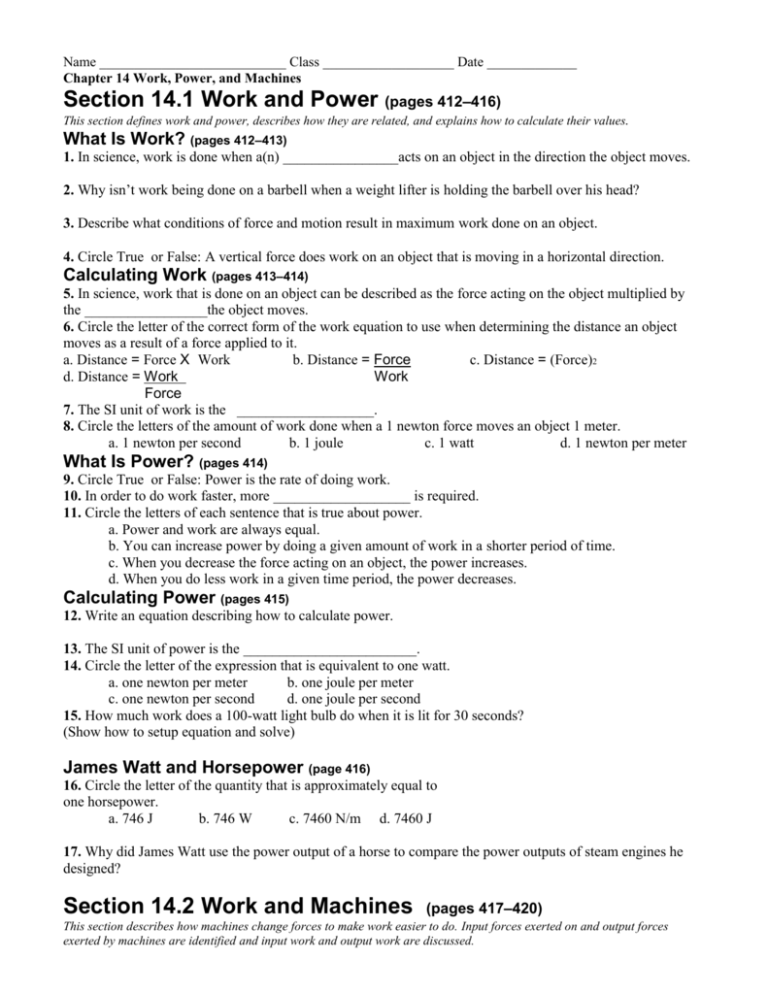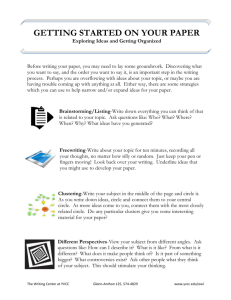File
advertisement

Name ___________________________ Class ___________________ Date _____________ Chapter 14 Work, Power, and Machines Section 14.1 Work and Power (pages 412–416) This section defines work and power, describes how they are related, and explains how to calculate their values. What Is Work? (pages 412–413) 1. In science, work is done when a(n) ________________acts on an object in the direction the object moves. 2. Why isn’t work being done on a barbell when a weight lifter is holding the barbell over his head? 3. Describe what conditions of force and motion result in maximum work done on an object. 4. Circle True or False: A vertical force does work on an object that is moving in a horizontal direction. Calculating Work (pages 413–414) 5. In science, work that is done on an object can be described as the force acting on the object multiplied by the _________________the object moves. 6. Circle the letter of the correct form of the work equation to use when determining the distance an object moves as a result of a force applied to it. a. Distance = Force X Work b. Distance = Force c. Distance = (Force)2 d. Distance = Work Work Force 7. The SI unit of work is the ___________________. 8. Circle the letters of the amount of work done when a 1 newton force moves an object 1 meter. a. 1 newton per second b. 1 joule c. 1 watt d. 1 newton per meter What Is Power? (pages 414) 9. Circle True or False: Power is the rate of doing work. 10. In order to do work faster, more ___________________ is required. 11. Circle the letters of each sentence that is true about power. a. Power and work are always equal. b. You can increase power by doing a given amount of work in a shorter period of time. c. When you decrease the force acting on an object, the power increases. d. When you do less work in a given time period, the power decreases. Calculating Power (pages 415) 12. Write an equation describing how to calculate power. 13. The SI unit of power is the ________________________. 14. Circle the letter of the expression that is equivalent to one watt. a. one newton per meter b. one joule per meter c. one newton per second d. one joule per second 15. How much work does a 100-watt light bulb do when it is lit for 30 seconds? (Show how to setup equation and solve) James Watt and Horsepower (page 416) 16. Circle the letter of the quantity that is approximately equal to one horsepower. a. 746 J b. 746 W c. 7460 N/m d. 7460 J 17. Why did James Watt use the power output of a horse to compare the power outputs of steam engines he designed? Section 14.2 Work and Machines (pages 417–420) This section describes how machines change forces to make work easier to do. Input forces exerted on and output forces exerted by machines are identified and input work and output work are discussed. Machines Do Work (pages 417–418) 1. Describe what a machine is able to do. 2. Circle True or False: A machine can make work easier to do by changing the size of the force needed, the direction of a force, or the distance over which a force acts. 3. Consider the equation Work = Force X Distance. If a machine increases the distance over which a force is exerted, the force required to do a given amount of work _________________________. 4. Give an example of a machine that changes the direction of an applied force.________________________ 5. When you make several trips to unload a few heavy items from a car instead of moving them all at once, the total distance over which you exert yourself ________________________. Work Input and Work Output (pages 419–420) 6. The work done by a machine is always less than the work done on a machine because of _______________. 7. Circle the letter of the definition for input force. a. the amount of force exerted by a machine b. the amount of friction slowing the speed of a machine c. the amount of work done by a machine d. the amount of force exerted on a machine 8. Write an equation that describes work input. 9. Circle True or False: Every machine uses some of its work input to overcome friction. 10. The force exerted by a machine is called the _______________________ force. 11. Circle the letter of the expressions that equals the work output of a machine. a. Input distance b. Output distance X Input distance Output distance c. Output distance d. Output distance X Output force Friction 12. Circle True or False: Output work always is less than input work. For questions 13 through 15, refer to the figure. 13. Which arrow shows the input force? List the letter of the figure. 14. Which arrow represents the input distance? List the letter of the figure. 15. Which arrow represents the output force? List the letter of the figure. 16. How can you increase a machine’s work output? Section 14.3 Mechanical Advantage and Efficiency(pgs 421–426) This section describes mechanical advantage and efficiency and how to calculate these values. Ways to maximize mechanical advantage and efficiency are discussed. Building Vocabulary As you read the section, write a definition for each vocabulary term. Mechanical Advantage Actual mechanical advantage Ideal mechanical advantage Efficiency Mechanical Advantage (pages 421–423) 1. The number of times that a machine increases an input force is the ____________________ of the machine. 2. For a given input force, what affects the output force that a nutcracker can exert on a nut? 3. Mechanical advantage describes the relationship between input force and ______________________ force. 4. How is the actual mechanical advantage of a machine determined? 5. Greater input force is required to move an object along a ramp with a rough surface, compared to a ramp with a smooth surface, because a greater force is needed to overcome __________________ . 6. Circle True or False: A loading ramp with a rough surface has a greater mechanical advantage than one with a smooth surface. 7. Because friction is always present, the actual mechanical advantage of a machine is never ______________ than its ideal mechanical advantage (IMA). 8. A machine’s ________________________________ is the mechanical advantage in the absence of friction. 9. What type of materials do engineers use to increase the mechanical advantage of a machine? Calculating Mechanical Advantage (pages 424–425) 10. Circle True or False: To calculate ideal mechanical advantage, divide input distance by output distance, and then divide the result by the force of friction. 11. Circle True or False: An inclined plane is an example of a machine. 12. Calculate the IMA of a ramp for the distances given in the table. Horizontal distance Vertical rise 1.5 meters 0.5 meters 12 meters 1.5 meters 3.6 meters 0.3 meters Ideal mechanical adv 13. Circle True or False: If the input distance of a machine is greater than the output distance, then the IMA for that machine is greater than one. Efficiency (pages 425–426) 14. Why is the efficiency of a machine always less than 100 percent? 15. Circle True or False: To calculate the efficiency of a machine, divide the work output by work input, and then multiply by 100. 16. What is a significant factor affecting a car’s fuel efficiency? __________________________________ 17. Calculate the efficiency of a machine with a work output of 120 J and a work input of 500 J. Show how to set up the equation and solve 18. Circle the letter of the work input for a machine with a work output of 240 J and an efficiency of 80 percent. a. 300 J b. 200 J c. 320 J d. 200 W 19. Reducing friction ___________________ the efficiency of a machine. Section 14.4 Simple Machines (pages 427–435) This section presents the six types of simple machines. A discussion of how each type works and how to determine its mechanical advantage is given. Common uses of simple machines are also described. 1. List the six types of simple machines. a. b. c. d. e. f. Levers (pages 428–429) 2. A screwdriver used to pry the lid off a paint can is an example of a(n) ______________________. 3. The fixed point that a lever rotates around is called the _____________________________. 4. To calculate the ideal mechanical advantage of any lever, divide the input arm by the______________. 5. What characteristics distinguish levers as first-class, second-class, or third-class? 6. Circle True or False: First-class levers always have a mechanical advantage that is greater than one. 7. Circle True or False: All second-class levers have a mechanical advantage greater than one because the input arm is longer than the output arm. Wheel and Axle (page 430) 8. Describe a wheel and axle. 9. Circle the letter of the sentence that describes how to calculate the IMA of a wheel and axle. a. Multiply the area of the wheel by the area of the axle. b. Divide input force by output force. c. Divide the diameter where input force is exerted by the diameter where output force is exerted. d. Divide the radius of the wheel by the force exerted on it. Inclined Planes (page 430–431) 10. A slanted surface along which a force moves an object to a different elevation is called a(n)___________ . 11. Circle True or False: The ideal mechanical advantage of an inclined plane is the distance along the incline plane divided by its change in height. Wedges and Screws (page 431) 12. A thin wedge of a given length has a(n)______________________ mechanical advantage than a thick wedge of the same length. 13. Screws with threads that are close together have a greater_____________________________. Pulleys (pages 432–433) 14. A simple machine consisting of a rope fitted into a groove in a wheel is a(n) ______________________. 15. What determines the ideal mechanical advantage of a pulley or pulley system? Compound Machines (page 435) 16. Circle True or False: A compound machine is a combination of two or more simple machines that operate together. 17. Circle each letters that identifies a compound machine. a. a car b. a handheld screwdriver c. a washing machine d. a watch WordWise Match the vocabulary term to the definition and place the letter of the term in the blank. Vocabulary Terms ______ 18. Work out X 100 Work input ______ 19. A mechanical watch is an example of this. ______ 20.One way to determine this is to divide output work by output force. ______ 21.This is the SI unit of work. ______ 22.On a lever, it is the distance between the fulcrum and the input force. ______ 23. The IMA of this machine increases as its thickness decreases relative to its length. ______ 24.This is exerted on a jack handle to lift a car. ______ 25. This unit equals about 746 joules. ______ 26.This is the distance between the output force and the fulcrum. ______ 27. This SI unit of power is used to describe light bulbs. ______ 28. The IMA of this machine is the distance along its surface divided by the change in height. ______ 29. A device that can change the size of the force required to do work. ______ 30. This quantity is equal to Work/Time. A. Compound machine B. Efficiency C. Horsepower D. Input arm E. Input force F. Inclined plane G. Joule H. Machine I. Output arm J. Output distance K. Power L. Watt M. Wedge




